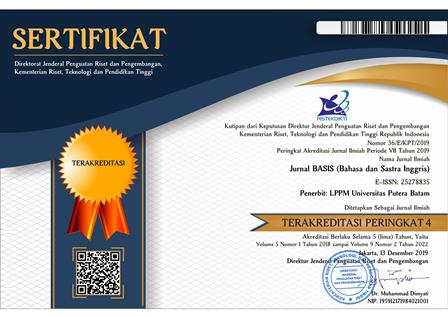THE CONCEPT OF ‘SUCCESSFUL COLLEGE STUDENT’ IN YOGYAKARTA PROTOTYPE SEMANTICS
DOI:
https://doi.org/10.33884/basisupb.v7i1.1801Keywords:
abstract concept, cognitive linguistics, semantic prototype, successful college studentAbstract
Manipulation and even murder case done by student to the teacher shocked Indonesians. These unexpected phenomena happened in university – the place where the students achieve their dreams and the new knowledge to nourish their brains – because of the undergraduate thesis. Therefore, this research aimed to discover the concept of “successful college student” in the respondents’ mind. The respondents were 200 students majority from one of private universities and twodifferent universities in Yogyakarta for each method. This concept portrayed the ideal college student in their mind by revealing the most ideal and successful student, so the goal of the college students can be well-described. This research used free listing with limited time, 30 seconds as the first step of collecting the data and judging the illustration as the second one. The first method was used to create the criteria that should be included in the illustrations. Those illustrations were judged by the respondents using semantic scale, 1-7 to represent from failed to successful. The result of this research showed the gradation of member in the concept of “successful college student” was different in age, semester and discipline category but they shared common prototypical concept that the successful college student should have high GPA, be smart, diligent and religious, and should graduate on time.
References
Akmajian, A., et al. (2010). Linguistics an introduction to language and communication. London: MIT Press.
Argus, A.A. (2016). Sadis, mahasiswa medan gorok dosennya di kamar mandi kampus. Retrieved on 18 Mei 2016 from banjarmasin.tribunnnews.com/2016/05/02/sadis-mahasiswa-medan-gorok-dosennya-di-kamar-mandi-kampus.
Barsalou, L.W. (2012). The human conceptual system. In Michael J Spivey., Ken McRae, Marc F. Joanisse (Eds.) The Cambridge Handbook of Psycholinguistics (pp. 239 – 258). New York: Cambridge University Press.
Berlin, B & Kay, P. (1969). Basic Color Terms: Their Universality and Evolution. Berkeley: University of California Press.
Briando, S. (2012). Tujuan mahasiswa kuliah agar mudah dapat kerja. Retrieved on 18 Mei 2016 from kompasiana.com/suryono.briando/tujuan-mahasiswa-kuliah-agar-mudah-dapat-kerja_5511023a813311373abc750b.
Coleman, L & Kay, P. (1981). Prototype semantics: the English word lie. Language, 57(1), 26-44. http://www.jstor.org/stable/414285?origin=JSTOR-pdf
Direktorat Pembelajaran. (2018). Panduan penyusnan kurikulum pendidikan tinggi di era industri 4.0. Retrieved from https://belmawa.ristekdikti.go.id/wp-content/uploads/2019/07/Panduan-Penyusunan-Kurikulum-Pendidikan-Tinggi.pdf
Evans, V., & Green, M. (2007). Cognitive linguistics: An introduction. Great Britain: Edinburgh University Press
Hampton, J.A. (2016). Categories, prototypes and exemplars. In Nick Riemer (Ed.) The Routledge Handbook of Semantics. New York: Routledge.
Holy Quran. (2004). The holy quran: arabic text and english translation. Trans. Maulawi Sher Ali. United Kingdom: Islam International Publications Limited.
Jusmaya, A., & Afriana, A. (2019). The effectiveness of semantic mapping as prewriting activity in argumenttaive writing. Jurnal Basis, 6 (1), 33 – 42. https://doi.org/10.33884/basisupb.v6i1.1052
Kay, P., & McDaniel, C.K. (1978). The linguistic significance of the meanings of basic color terms. Language, 54 (3), 610-646.
https://www1.icsi.berkeley.edu/~kay/K&McD.LG.pdf
Keraro, F.N., & Okere, M.I.O. (2009). Cultural Influences on the Learning of Natural science: An African Perspective. In Jonathan E. Larson (Ed.). Educational Psychology. New York: Nova
Lyon, J. (1968). Introduction to Theoretical Linguistics. Great Britain: Cambridge University Press
Oktavia, Y. (2019). Pemerolehan semantik bahasa minangkabau anak usia tiga tahun. Jurnal Basis, 3 (2), 55-63. http://ejournal.upbatam.ac.id/index.php/basis/article/view/1038
Risnawati, R. (2011). Mahasiswa-kuliah-organisasi-kerja-main. Retrieved on 30 May 2020 from http://www.kompasiana.com/risnawatiririn/mahasiswa-kuliah-organisasi-kerja-main.
Rosch,.et al. (1976.) Basic objects in natural categories. London: Cognitive Psychology Press
Sousa, D.C.P., et al. (2016). Information retrieval during free listing is biased by memory: evidence from medical plants. Plos One 11(11). Doi:10.1371/journal.pone.0165838
Ungerer, F., & Schmid, H. (2013). An introduction to cognitive linguistics. New York: Routlede
Walter, E (Ed) .(2008). Successful. In Cambridge Advanced Learner. Computer software.
Downloads
Published
Issue
Section
License













 JURNAL BASIS (BAHASA DAN SASTRA INGGRIS)
JURNAL BASIS (BAHASA DAN SASTRA INGGRIS)
